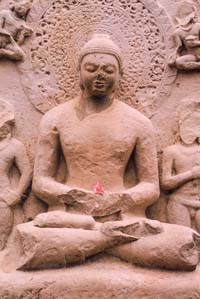 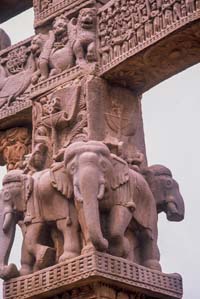  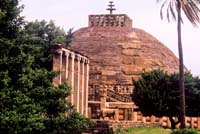  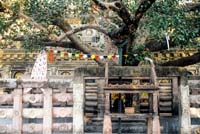  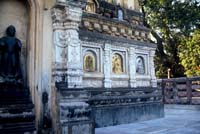 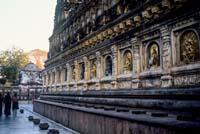 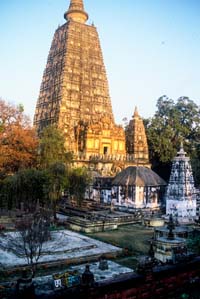   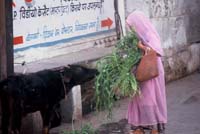 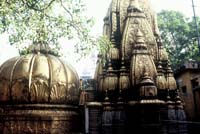 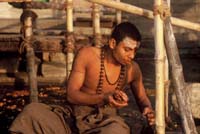 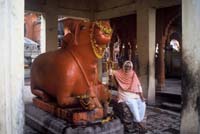 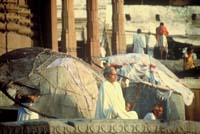 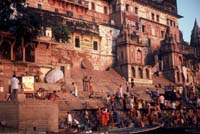 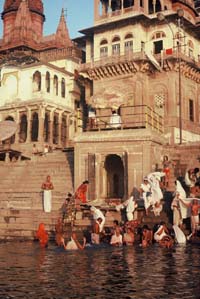  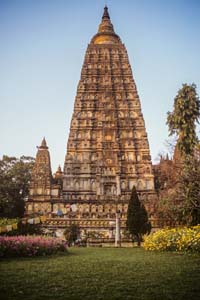  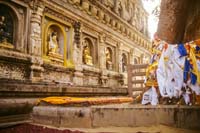 |
IN THE FOOTSTEPS OF THE BUDDHA 19 Days from Delhi Day 1 – Delhi Late in the afternoon, board a sleeper train for the overnight journey to Gorkhpur, nearest railhead to Lumbini which lies just inside the Nepalese boarder. Check your Indian visa – you will need a multiple entry visa for this trip. Day 2 – Lumbini In about 536 B.C., Queen Maya of the Shakya Kingdom was on her way to her family home in Devadaha for the birth of her child when she stopped to rest in the shade of the Sal trees of the Lumbini gardens. As she reached up to pick a flower from a tree, Siddhartha Gautama, the future Buddha, was born. Legend says that Nagas (sacred snakes) washed him with water from nearby water tanks and that even the great God Brahma came to wait on him. These beautiful gardens at Lumbini were neglected after the death of Emperor Ashoka and only recently have the stupas, viharas, and palaces been excavated and partially restored. Today, this peaceful and quiet place is a major place of pilgrimage for Buddhists from all over the world. Besides Ashoka’s famous edict pillar, pilgrims can visit many new shrines and monasteries which have been built here. Hotel – Lumbini Guest House Day 3 – Lumbini to Kushinagar The plains of northern India are covered with memories of the Buddha’s life, and your drive today takes us to Kushinagar, site of the Buddha’s Mahaparinirvana. When the 81 year old Buddha fell ill here, Ananda, in despair, said “Please, let not the exalted one die here in this little wattle and daub village in the middle of the jungle.” But today, this site of his cremation is alive and vibrant. Monks wearing the different colored robes representing the various sects – saffron from Thailand and Sri Lanka, maroon from Tibet, and grey from Japan – quietly chant as they wander through the gardens and circumambulate the shrines. Hotel – Pathik Niwas Day 4 – Kushinagar to Patna “How delightful a spot is Vaisali”, said the Buddha about his favorite place where he used to linger in the beautiful shrines honoring the local gods. After his death, the Second Buddhist Council was held here. Vaisali today has one of the least damaged Ashokan pillars and a museum with some good examples of early Buddhist art. Patna (the ancient city of Pataliputra), where you overnight was just coming into its own during the later years of the Buddha’s life when it was made the new capital of the Magadhan empire, but unfortunately, little remains from that time. Hotel – Pataliputra Ashok Day 5 – Patna to Bodh Gaya Attracted by the environment of religious free-thinking, Siddhartha Gautama, after leaving his palace-home in Sakya, first went to Ragagaha, capital of the kingdom of Magadha. Here, he won the admiration of King Bimbisara who was to give the Buddhist order its first landholdings, the Bamboo Grove Monastery. We can visit the remains of this place which was so loved by the Buddha, and then you can walk to the top of Vulture Peak where he gave the “Second Turning of the Wheel of the Law” to 5000 members of his Sangha. A chairlift rewards the visitor with impressive views of the countryside as it takes us to the summit of the highest hill to visit the beautiful stupa, built by the Japanese to commemorate this site of the First Buddhist Council. A short distance from Rajgir are the remains of the Monastery of Nalanda which have been painstakingly and lovingly excavated in an attempt to recapture the sense of peace and tranquility of times past. This was the most prestigious Buddhist university of its time and its list of distinguished professors include Nagarjuna and Naropa, both of whom played a vital role in the development of Buddhism in Tibet. Hotel – Several of the monasteries have accommodations that are open visitors. Last time I was there, the Bhutanese Monastery was the most comfortable, but check with your tour operator. Otherwise, there are several large hotel chains there. Day 6 – Bodh Gaya Bodh Gaya is probably the most active center of Buddhist pilgrimage in India today, and at any given time, thousands of devotees will be here to worship at the place where the Buddha first became enlightened after six years of devout austerities. People come to tie colored scarves around the sacred Bodhi tree, a descendent of the one under which the Buddha sat. They circumambulate the spectacular Mahabodhi Temple, and at night a profusion of candles bathe the temple grounds in a magical soft glow. Several organizations and countries have built temples in this area, each in their own unique and special local style. The temples from Thailand, Japan, Tibet and the Indian state of Sikkim are among the most spectacular and the artwork here is unequaled anywhere in India. Day 7 – Bodh Gaya to Varanasi After some time at the temple in the quiet early morning hours, set off with your car and driver for Varanasi. Stop midway to take a look at the tomb of Sher Shah Sur, one of India’s greatest Moslem statesman of the 16th century. His tomb, set in the middle of a small lake is a beautiful example of early Afghan Islamic architecture. Explore the city of Varanasi or to the banks of the Ganges river for the sunset aarthi ceremonies. Day 8 – Varanasi During the life of the Buddha, Varanasi was known as Kashi, the “City of Light”. Even in his time, it was an ancient and holy city, richly forested and scattered among hundreds of little lakes. Being the intellectual and Brahmanical religious center of the Gangetic plain, it was only natural that the Buddha should go there after he left Bodh Gaya. Early in the morning, board your boats to witness a sight that surely must have also fascinated the Buddha. Thousands of Hindu devotees, along the banks of the Ganges, there to cleanse their souls in the purifying waters and gain release from Samsara, the endless round of birth, death, and re-birth. A walk through the labyrinth of ancient narrow alleyways leads you to a few of the almost 2000 temples dedicated to Lord Shiva. Later in the afternoon, you can have your car take you the short distance to Sarnath, the Deer Park where the Buddha preached his first sermon, known as “The Turning of the Wheel of the Law”. Several excavated stupas remain here including the huge Dhamekha Stupa, built to commemorate the spot of that famous sermon. The museum here contains perfectly preserved examples of sculptures from this site as well as the famous Ashokan lion capital which is now the national symbol of India. Hotel – Palace on the Ganges Day 9: Varanasi to New Jaipalguri Take the day to soak up the ambiance of this amazing city or, perhaps, seek out a Yogi on the banks of the river. Perhaps visit the Sanskrit University. India’s most renowned center for classical Sanskrit studies This beautiful tree shaded campus also houses a supurb collection of miniature paintings. Later, we board our train for the overnight journey to New Jaipalguri, railhead for Darjeeling. Accommodations: First class train Day 10: Darjeeling Darjeeling, according to the Shambhala legend, is one of the “Hidden Valleys” set aside as sanctuaries for devout Buddhists during times of troubles. It is easy to see how such a romantic mystique grew around this enchanting hillside locale. So different from the Indian plains that we leave behind as you drive up the steep winding road, through the flickering teak forests, and lush tea plantations. Rapidly gain altitude until the 28,200 ft Mt Khanchenjunga, the “King of Mountains”, dominates the northern horizon, its massive white snow summit brilliant against the indigo skies. Darjeeling is a perfect place for walks in the foothills with fabulous Himalayan vistas as a backdrop. Take the afternoon to explore some of the paths leading to old monasteries tucked away in the folds of the hills. There are many heritage hotels in Darjeeling – from the old original Windermere to the upscale New Elgin. Day 11: Darjeeling Early to rise this morning to watch the sun come up over Himalayas from the viewpoint at Tiger Hill. Khanchenjunga, the third highest mountain in the world, is surely one of the most impressive, and sunrise here is a spectacle not to be missed. Its name, “Khanchenjunga ” translates as “Mountain of the Five Jewels”, and it is sacred to the Buddhists who believe that the jewels to finance the coming age of Shambhala are buried in the valley below the peak. Stop off at the Yiga Choling Monastery (mentioned by Lama Govinda in his book “Way of the White Cloud”) to see the graceful stature of the Buddha Maitreya, the Buddha of the future. This afternoon, you might want to visit the Tibetan Refugee Craft Center and watch hand knotted rugs being made or learn the techniques of painting thankas Day 12 – Darjeeling to Pelling One of the best places to get a look at Buddhism in practice today is Sikkim, home to many Tibetan refugees, and virtualy inaccessable until recently. This was an officially Buddhist kingdom until it became part of India in 1975. Vajrayana Buddhism sets the mood here. Graceful prayer flags, fabled monasteries, incense, and chanting monks give this whole area an aura of mystery. Head for Pemayangtse, the “Sublime Perfect Lotus”, and seat of the Nyingmapa sect in Sikkim. This 17th century monastery is the second oldest in Sikkim and is blessed with spectacular views of nearby Khanchenjunga. Inside the monastery is an amazing carved miniature wooden pagoda, five years in the making by the late Dungzin Rinpoche. This ceiling high temple depicts Guru Rinpoche’s celestial abode of Sangthokpalri. Hotel – There is a wonderful colonial era hotel here called the Mount Pandim. It has magnificent mountain views from their back lawn and is a short walk to Pemayangtse. Day 13: Pemayangtse There are a couple of options today for excursions. If you fancy a walk in gorgeous mountain scenery, have your driver take you closer to Mt Kanchenjunga, to Yuksom. There is a nice full day hike to Tashiding. Plan ahead –all total, it will take you about 7 hours. If you feel more relaxed, take your car out to Lake Kechapari, the Wishing Lake which is a favorite gathering spot for Sikkemese families. A charming legend claims that whenever a leaf drops into this lake, a magical bird swoops down and plucks it away. Indeed, it is odd that there never seems to be a leaf floating on its surface. There are very nice walks around this lake among the hills and prayer flags. Later in the afternoon, return to the monastery to talk with the monks while sitting in the shadow of Mt. Khanchenjunga. When you return to Pelling, you might want to visit the Sanga Choling Monastery which is on the other side of the valley. It has a great little cluster of chortens. Day 14 – Pemayangtse to Gangtok This morning, return to Gangtok through majestic mountain scenery and charming Sikkemese villages. There is, as well, a small Bon-po monastery where amiable and hospitable monks are eager to show guests around and discuss Tibet’s earliest indigenous religion. After your arrival in Sikkim’s capital city, you could visit Enchey Monastery whose name means “Place of Solitude”, so designated from its earlier days as a Nyingmapa hermitage. Close by is the internationally acclaimed Institute of Tibetology. This renowned library contains 28,000 Buddhist manuscripts, making it the largest collection in the world. Priceless icons, ritualistic items, and rare thankas complete this dazzling collection. Hotel – The Norkhil Hotel was once the Choygal’s personal guesthouse. It’s now rum by the Elgin Company so you know it will top notch service. Day 15 – Gangtok Rumtek Monastery, just outside Gangtok is the seat of the Kargupa sect in India. Built by the late 16th Gyalwa Karmapa in 1976, this is a replica of the now destroyed Tolung Tsurpu Monastery in Tibet. This is one of the largest and most active monasteries in India with over 100 monks in residence and it has some of the most beautiful frescos to be found outside of Tibet. The enormous and elaborate reliquary stupa of the 16th Karmapa is plated in gold and embellished with chunks of turquoise and coral as big as a fist. Stay here at Rumtek as long as you wish and the balance of the afternoon will be free in Gangtok to shop for prayer flags or just soak up the ambiance of this remote and timeless land. Day 16 – Gangtok to New Delhi High mountains and green forests give way to the great Indian plains again today as you drive downhill from Gangtok to Bagdogra for the flight back to Delhi. Day 17 – New Delhi to Bhopal The Shatabdi Express, India’s most modern and comfortable train pulls out of the New Delhi Railway Station early in the morning for the eight hour ride to Bhopal. The time passes quickly however, because of the interesting countryside and fascinating local life through which you pass. Dazzling palaces and forbidding forts spring up unexpectedly, seemingly out of nowhere all along this route. Arrive in Bhopal early in the evening. Day 18 – To Sanchi The Emperor Ashoka built the great stupa at Sanchi in the 3rd century primarily to hold relics from the Buddha, but also to serve as a teaching college. Now, it is the most perfectly preserved stupa in India, famous for its superb delicate bas relief carvings which depict scenes from the Buddha’s life or fables from the Jataka tales. The four magnificent toranas (entry gates) which are carved from stone to replicate the wood gates of ancient villages miraculously still stand. Graceful carved stone Yakshis (female tree spirits), massive elephants, and majestic lions draw art historians from all countries to study the development of Buddhist art and architecture. Day 19 – Bhopal to New Delhi The capital of the state of Madhya Pradesh, Bhopal sits on the banks of two man-made lakes. Take the morning to look around, possibly to visit the huge Taj-ul-Masjid, one of the largest mosques in India. Set on top a small hill, the stately Laxmi Narayan Temple offers splendid views over the city which can be enjoyed from this very pleasant spot. Later in the afternoon, the Shatabdi Express will return you to Delhi, arriving back at about 10:00PM. |
